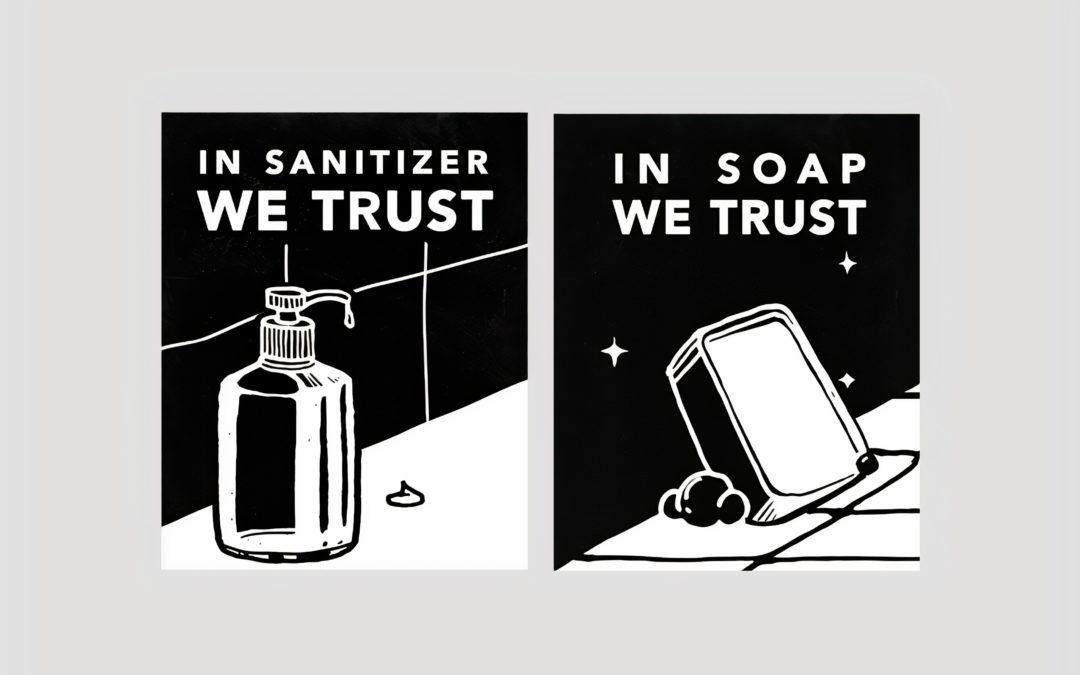Even with a light at the end of the COVID-19 tunnel, we still want to keep our homes clean and disinfected. Or is it sanitized? What’s the difference between disinfecting and sanitizing? Or are they the same?
Disinfecting and Sanitizing: What’s What?
While you may think that disinfecting and sanitizing are words that can be used interchangeably, there are subtle differences.
Disinfecting uses chemicals to kill germs. Because the germs are removed, the risk of infection is reduced significantly. Disinfecting is not necessarily cleaning.
Sanitizing is the act of reducing the number of germs to a safer level in alignment with public health standards. This involves cleaning with soap and water to remove dirt and get rid of germs.
In your home, it’s practically impossible to disinfect everything, so your goal should be to clean and sanitize thoroughly. And then you can spot disinfect those areas that need it the most. Where should you focus your time though? And how do you properly clean, sanitize, and disinfect your home to keep your family safe?
Focus on High-touch Areas
There are certainly some areas in your home that need to be cleaned more frequently than others. In fact, these may be the places that need a combination of disinfecting and sanitizing from time to time.
Entry Doors
Whether you enter your home through the front door, back door, or garage door, these are probably some of the dirtiest parts of your house. That’s because you and everyone in your home (and guests as well) use the doors, knobs, and locks throughout the day, tracking in whatever is on your hands from the outside.
Plan to clean your doors regularly with soap and water (or other cleaner). Then spray with a disinfectant and let sit for a few minutes before wiping clean. This will help keep germs from tracking into your home.
Remember that the first 5–10 feet inside your house are probably the dirtiest. That includes doors, floors, and light switches. Make a plan to clean, sanitize, and disinfect these areas more frequently.
Faucets in the Kitchen and Bathroom
When family members enter those doors and want to clean up, they head right to a sink. The sinks in your bathrooms and kitchen have likely seen higher usage in the last year as we’ve all upped our hand-washing. But although our hands come away clean, remember where they were before you started washing—and how dirty those faucets can be.
As with doors, be sure to do some disinfecting and sanitizing of your faucets. Put these into rotation with your doors.
And remember that, after you clean and sanitize, disinfect—and let the disinfectant sit for a minute or two before wiping clean. (Be sure to read the directions to know how long.)
Tools of the Trade
To be sure you’re disinfecting and sanitizing properly, you need the right tools for the job.
Microfiber Cloths
While you may think paper towels, an old towel, or a T-shirt are the best options for cleaning your house, a microfiber cloth does a much better job of getting rid of germs.
With just a microfiber cloth and water, you’ll effectively remove most foreign materials—and leave a streak-free clean! Microfibers are also lint free, nonabrasive, hypoallergenic, environmentally friendly, washable, reusable, and super absorbent. Basically, they are a must for a clean home.
Soap and Water
While you may want to reach for some special cleaner, in most instances, plain old soap and water do the trick better than anything else. If you want to add a little something extra, instead of choosing harsh chemicals for cleaning and sanitizing, try lemon juice, baking soda, and vinegar. Used alone or together, they pack a powerful punch.
Disinfecting Requires Chemicals
To actually kill germs, you will need to use chemicals. It may not be your first choice, but sometimes you need to bring out the big guns. The Environmental Protection Agency recommends a number of chemicals to combat COVID-19, as well as any other germs you’re concerned about eliminating. If you want to keep it simple, you can mix one-third cup of bleach with a gallon of warm water. Put that in a spray bottle and let sit as you would with any store-bought disinfectant.
Remember to read the labels on any chemicals you’re using for disinfecting and sanitizing to ensure you’re applying and letting them sit as directed.
Carnation Home Cleaning Is Your Disinfecting and Sanitizing Helper
Whether you’re concerned about COVID-19 or just everyday germs your family tracks into your home, having a regular cleaning crew can help reduce your chances of getting sick. With Carnation Home Cleaning on your team, we’ll perform whole-house cleans in addition to paying special attention to those high-touch areas. Plus, we’ll clean everything in addition to disinfecting and sanitizing.
Rest easy. We got this.











